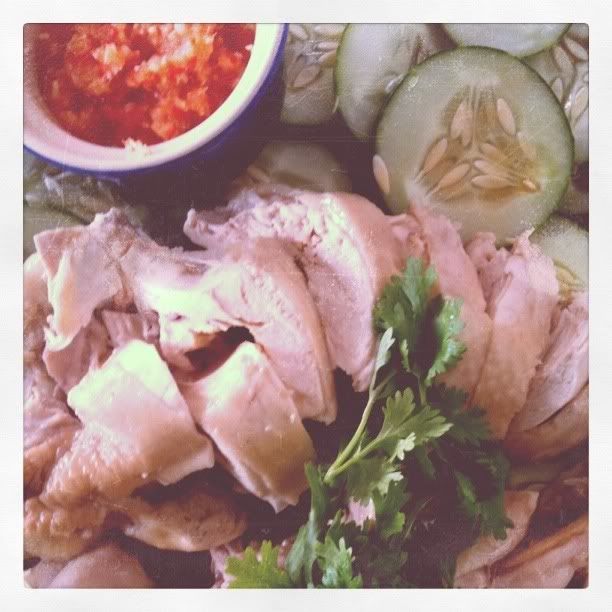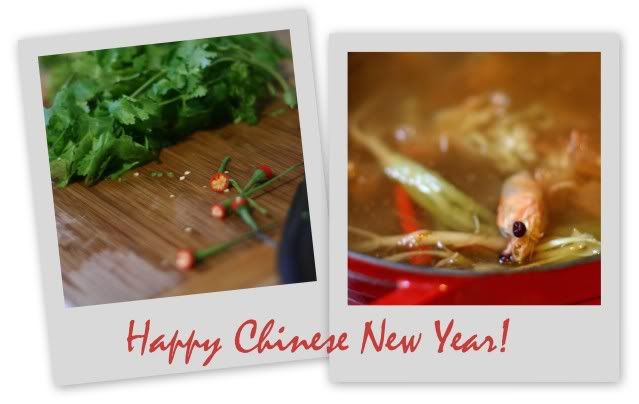A quick glance at my ever expanding collection of cookbooks and it wouldn't be too difficult to identify what kind of food I am more inclined to cook. While my palate takes to Mee Hoon Kuay and Murtabak as comfortably as Aglio Olio and Duck Confit, my kitchen endeavours typically involve more thyme, rosemary and sage, than candlenuts, lemongrass and belachan.
I usually justify this by saying that it doesn't make sense trying to make from scratch a dish like Laksa (springy rice noodles in a rich, coconut-based broth that is indescribably flavourful from all the spices and herbs involved), when it can be easily purchased at a paltry sum of SGD$3 after a mere 5 minute walk, which is great for working up a mini appetite. It just seems like a helluva lot of work trying to match something that has already achieved phenomenal standards elsewhere. It felt like I was trying to reinvent the wheel.
At the end of the day however, I think I was just trying to find excuses not to try something that seemed so labour intensive. So I really admire
people who actually bother trying to make Laksa.
Recently, I decided that I would try to push my limits and step out of my comfort zone within my comfort zone, if that makes sense. Basically, I'd still be working in my kitchen, the place I do so much cooking, baking, and smiling. But instead of cream, I'd have to use coconut milk. In place of dried parsley, I'd be using crushed coriander seeds. I would finally try cooking from the neighbouring region, using
'Inside the Southeast Asian Kitchen' as my tutor.
If you ever chance upon previous editions of cookbooks commissioned by ASEAN, I'm pretty sure you'd be, like I was, aghast about everything in it - from the layout to the writing and to the photos, or rather the lack of. As I slowly thumbed through the pages in the latest and far more attractive cookbook though, I could not help but flag out certain recipes I thought seemed easy yet interesting enough to try.

One of these was for Gudeg Yogya, long-cooked chicken and jackfruit (Yogya style). It didn't look like an overly painful process, though it did involve plenty of 'foreign' ingredients to me. When I decide to whip up something from my Damien Pignolet's French, or Jane Lawson's Cocina Nueva, I usually have about 80% of the ingredients in my cupboards just waiting to be used. However, I found that with this, I had to practically start from scratch and source for 80% of the ingredients on the list.
Jackfruit was also something I had never handled before. Thankfully, I met a superb vegetable/herbs/spices lady in Tekka Market, who sold virtually anything I needed to cook dishes from around the neighbouring countries. While wrapping the jackfruit up for me, she also gave me wise tips on managing the sap that oozes out when you slice the skin away (basically, keep wiping the knife with oil in between each slice).
Though, after all that effort I think I'll leave it to the pros next time. Coincidentally, I passed by a fruit seller in Tekka Market today, who was removing the flesh from the fruit. The deft of hand he had when dealing with the jackfruit was amazing, and he did it in a mere fraction of the time too.
Anyway, I went home happy with my loot and set to work almost immediately. Within 2 hours (though the chicken would have benefitted from a little more slow simmering), I managed to put together the Gudeg Yogya and a Chuchi pra kong (Chhouchi fragrant shrimp from Cambodia). The shrimp was supposed to involve some pounding, but a lack of a mortar and pestle meant that I had to resort to using a blender, which I knew would produce an inferior result. But I had no choice at that time, and am now eyeing a particular set I saw in a Korean minimart!
My family seemed pretty surprised that I made something so out of character for dinner that night. But I have to admit that I definitely felt like a fish out of water throughout the entire process. From the time I stepped into Tekka Market, looking for candlenuts without knowing how they even looked like, to the moment I took a peek into the pot of Gudeg Yogya, wondering if the jackfruit was supposed to take on that unappetising shade of earth-brown.
There was definitely plenty of room for improvement - I could have used Jackfruit that was a little more ripe, I could have added fewer than required dried red chillies to the Chuchi pra kong (it was incredibly spicy and my whole family was sniffing away by the end of the dinner), and I could definitely have stewed the chicken a little longer. What I also learnt is that my fears of cooking anything that required asian herbs and spices, were unfounded. Of course, that could be because I merely took the blender out and blitzed the herbs and spices together into a thick paste for each of the dishes.
Still, it is a start. I may not make perfect Indonesian chicken stew or Cambodian fragrant shrimp, but I've tried and can only get better from here.

In the meantime, at least I can say that I can steam fish! It is such a simple process, requiring only the freshest of ingredients for success. And it was one of the first few things my grandma and my mum taught me when I was tall enough to look down on the kitchen counter. I also If I could count the total number of hours I've spent picking fish meat from their bones, that might add up to quite a hefty sum.
Gudeg Yogya
Serves 6-8 for breakfast
Ingredients
1 medium chicken, ready for roasting
1 tsp salt
1 lemon, juiced
850ml thick coconut milk
1.1liters thin coconut milk
3 salam leaves (or bay leaves)
3 cm piece galangal (blue ginger)
900 g parboiled jackfruit segments (or canned green jackfruit drained and rinsed)
6-8 hard-boiled eggs, peeled (which I omitted)
Bumbu Paste
5 chopped shallots
5 cloves garlic, chopped
1 tsp chopped ginger
8 kemiri (candlenuts) or macadamia nuts, or 10 blanched almonds, chopped
2 tsp ground coriander
1 tsp crumbled terasi (shrimp paste)
1 tsp ground white pepper
1 tsp sugar
1 tsp salt
Method
Rub outside of whole chicken with salt, then liberally rub the juice of the lemon all over the chicken. Wrap chicken loosely in aluminium foil, and roast in a pre-heated oven at 330 degrees Fahrenheit (165 degrees Celcius) for 1 hour.
Unwrap and chop the chicken into 8 or 10 portions, discarding some of the large bones.
(Alternatively, the whole chicken can be boiled with water in a separate saucepan, for 50 minutes from the time the water starts to boil.)
Blend all the ingredients for the bumbu with 8 tbspns of thick coconut milk until smooth and transfer it to a saucepan. Bring to the boil and simmer, stirring often, for 6 minutes.
Add thin coconut milk, salam or bay leaves and galangal, and continue to simmer for 10 mins. Add jackfruit, increase the flame and boil for 40 minutes.
Now add the remaining thick coconut milk, the chicken and eggs. Continue to simmer, stirring often, for 30-40 mins or until the sauce becomes quite thick.
Serve hot with plenty of boiled rice. The more the merrier!
As I only started cooking at 6pm, and had to speed through dinner preparation, I could not give the jackfruit nor the chicken the time they needed to soften into melt-in-your-mouth tenderness. It was therefore much yummier the day after. It might sound like a lot of work, but it actually is not. It just needs a little bit more time and patience.





























